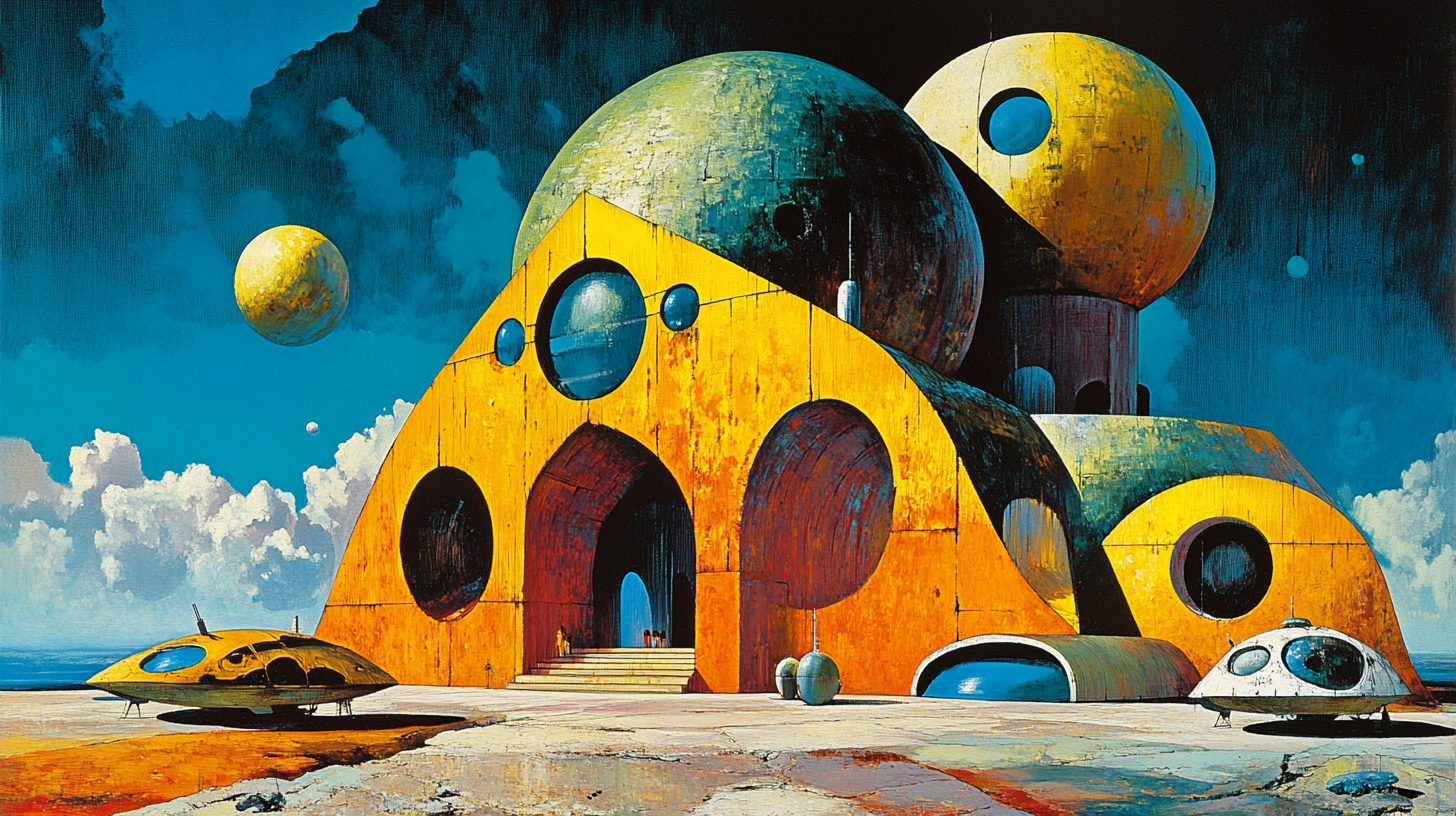"Foundation" Shows the Future Through the Lens of History
Isaac Asimov's "Foundation" explores the fall of empire through science and strategy, offering a timeless vision of civilization shaped by knowledge, planning, and the power of ideas.

When "Foundation" was first collected into a single volume in 1951, it marked a pivotal moment in science fiction literature. What had begun as a series of short stories in "Astounding Science Fiction" throughout the 1940s now stood as a unified vision of civilization's struggle against entropy. Its author, Isaac Asimov, already recognized for his work in robotics and rationalist storytelling, elevated the genre by introducing a speculative framework rooted not in gadgets or warfare, but in the long arc of historical inevitability.
Asimov's ambition was both grand and methodical. In "Foundation," he proposed a future where the collapse of a galactic empire was not a matter of space opera theatrics, but the predictable result of mathematical certainty. At the heart of the novel is the concept of psychohistory—a fictional science that applies statistical analysis to forecast the behavior of large populations. This idea, while impossible in practice, allowed Asimov to blend historical theory with science fiction in a way that was entirely new for the genre.
What distinguishes "Foundation" from its contemporaries is its intellectual focus. The story operates at the level of institutions, ideologies, and turning points in the fate of civilizations. In doing so, it offered a model for science fiction as a serious mode of cultural thought. The novel has since influenced not only writers, but economists, political theorists, and historians who see in its pages a reflection of mankind's perpetual attempt to impose order on chaos.
The World of Hari Seldon: Civilization on the Brink
The stage on which "Foundation" unfolds is vast. It is an aging Galactic Empire that stretches across the Milky Way, weighed down by bureaucracy, complacency, and inertia. At its height, the Empire represents the pinnacle of human organization and technological power. Yet beneath the surface lies quiet decay. The outer worlds are restless. Officials care more about appearances than substance. Progress has slowed to a crawl. Asimov presents this galactic order with deliberate control, drawing a clear parallel to the decline of Rome.

Rather than portraying collapse through chaos or spectacle, Asimov focuses on decline as a predictable process. The fall comes not from a single event but from a gradual failure of vision and discipline. His perspective is not apocalyptic but analytical. The reader is asked to consider how civilizations weaken when knowledge becomes stagnant, and tradition replaces innovation.
In this context, Hari Seldon becomes a pivotal figure. He is not a conqueror or a rebel but a scientist who sees the fall of the Empire as unavoidable. Seldon does not attempt to stop it. Instead, he proposes a long-term solution. His answer is the Foundation, a small colony placed on the edge of the galaxy. Its mission is not to save the Empire but to preserve humanity's technical legacy and to rebuild when the time is right.
Asimov builds his future world with rational precision. His tools are not swords or starships but systems and ideas. The society he envisions is grounded in real human tendencies and historical repetition. What gives "Foundation" its unique character is this commitment to portraying the future as a continuation of familiar patterns. He treats history as a system, not a story. In doing so, he offers a vision that challenges the reader to reflect on the structures that uphold any civilization.
A New Kind of Storytelling
"Foundation" does not follow a conventional narrative. There is no central hero whose journey anchors the plot. Instead, the novel is built from five separate stories, each focusing on a different moment in the Foundation's early history. These segments span decades, even centuries, and feature entirely new characters from one to the next. The connective tissue is not personality but purpose. What unites the stories is a shared commitment to the long plan set in motion by Hari Seldon.
This structure was unusual even by the standards of mid-century science fiction. Readers expecting a sweeping adventure driven by a recurring cast often found themselves disoriented. Some early critics noted the absence of emotional depth and interpersonal drama. The characters, while competent and clever, tend to serve the plot rather than drive it. Their inner lives are rarely explored in detail.
Yet this design is not a flaw. It is a deliberate choice. By removing the familiar anchor of a protagonist, Asimov elevates ideas to the forefront. The true character of the book is the Foundation itself, and the evolution of its strategy over time. Each chapter functions as a case study in how reason, knowledge, and foresight can overcome threats without resorting to force.

The result is a story with a mythic quality. The episodic format lends a sense of chronology and legacy, as if one were reading the early chapters of a much larger historical record. The tone is impersonal but not cold. Asimov is less interested in what individuals feel and more focused on what societies become. This approach gives "Foundation" its lasting distinction. It is not a tale of adventure, but of civilization in motion—an intellectual epic driven by cause and consequence rather than character and conflict.
Science, Strategy, and Civilization
"Foundation" is not a tale of battles won with lasers or fleets. It is a story where knowledge is the dominant weapon, and where the real victories are achieved through strategy and persuasion. Asimov's vision of power is both subtle and expansive. In the absence of a standing army, the Foundation relies on science as its chief instrument of influence, deploying it with remarkable flexibility and ingenuity.
In the early phase of the story, seen in "The Encyclopedists," the Foundation appears to exist only to compile knowledge. But beneath that surface lies a deeper purpose. When political pressure mounts, the Foundation does not respond with defiance. It uses its scientific understanding to create dependency among its neighbors. The outer worlds, having lost access to advanced technology, now view the Foundation's devices with awe. Through careful presentation, science becomes indistinguishable from religion. This shift is not accidental. It is part of a calculated effort to transform knowledge into authority.
Later, in "The Mayors" and "The Traders," the strategy evolves again. Religion gives way to commerce. Foundation agents spread influence through trade agreements and technological exports. These transactions are more than economic. They are political tools that bind distant planets into a growing sphere of control. Trade becomes diplomacy. Profit becomes policy. The Foundation's reach expands not through conquest, but through consent and necessity.
This evolution highlights Asimov's core belief—that ideas, when properly managed, can shape the fate of entire societies. His characters succeed not by overpowering their enemies, but by outthinking them. In this way, knowledge serves not just as a means of understanding the world but as a force to direct it.
Underlying it all is the tension between determinism and free will. The Foundation operates under a plan that spans centuries, yet its survival depends on individuals making the right decisions at the right time. Asimov offers no easy answers. He presents a world where progress is possible, but never guaranteed. In doing so, he reminds us that the strength of a civilization lies not in its armies, but in the clarity of its purpose and the courage of its intellect.
The Architecture of Endurance
"Foundation" continues to stand tall as one of science fiction's most respected achievements. Its reputation was secured in 1966 when it received the Hugo Award for Best All-Time Series, placing it alongside the most revered works of the genre. Yet its endurance owes less to accolades and more to the seriousness with which it treats civilization, science, and the limits of human control.
For readers interested in the forces that shape history, "Foundation" offers more than entertainment. It is a meditation on how knowledge, when organized and preserved, can serve as a bulwark against collapse. Its ideas remain timely, especially in an era where social, technological, and institutional stability feels increasingly fragile.
Asimov did not write a story about saving the world through heroism. He wrote about saving it through planning, patience, and faith in reason. That message is as bold today as it was when the stories first appeared. "Foundation" invites the reader to think beyond the moment and consider the long game.
For anyone who values science fiction that asks hard questions and offers sober hope, this book remains essential reading. It is not only a classic. It is a blueprint for how stories can shape our understanding of civilization itself.

